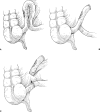Historical perspectives in the care of patients with enterocutaneous fistula
- PMID: 21886462
- PMCID: PMC2967312
- DOI: 10.1055/s-0030-1262980
Historical perspectives in the care of patients with enterocutaneous fistula
Abstract
Evidence can be found throughout surgical history of how devastating an enterocutaneous fistula (ECF) can be for both patient and surgeon. From antiquity, this complication of abdominal surgery, malignancy, radiation, trauma, or inflammatory processes has been a significant challenge to surgeons due to high associated mortality and significant morbidity. An ECF causes dehydration, malnutrition, skin excoriation, and sepsis, and has profound psychological effects on the patient. Recent mortality rates of patients suffering an ECF approach 20%. The authors illustrate the history of management of patients with ECF and discuss advances in perioperative care including parasurgical care, nutrition, wound care, and the history of surgical techniques.
Keywords: Enterocutaneous fistulas; historical review.
Figures


References
-
- The American Heritage Dictionary Fourth College Edition Boston: Houghton Mifflin Company; 2010.
-
- Fischer J E. The pathophysiology of enterocutaneous fistulas. World J Surg. 1983;7(4):446–450. - PubMed
-
- Judges 3: 21–22.
-
- Graney M J, Graney C M. Colorectal surgery from antiguity to the modern era. Dis Colon Rectum. 1980;23(6):432–441. - PubMed
-
- Devlin H B, Elcoat C. Alimentary tract fistula: stomatherapy techniques of management. World J Surg. 1983;7(4):489–494. - PubMed

